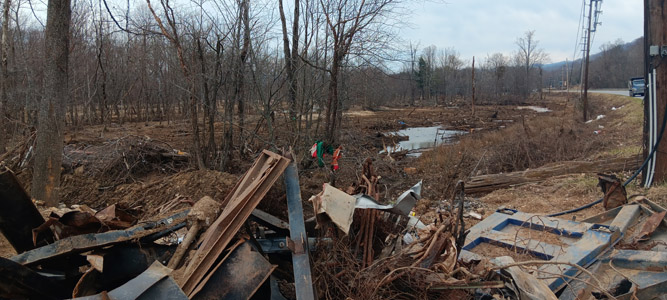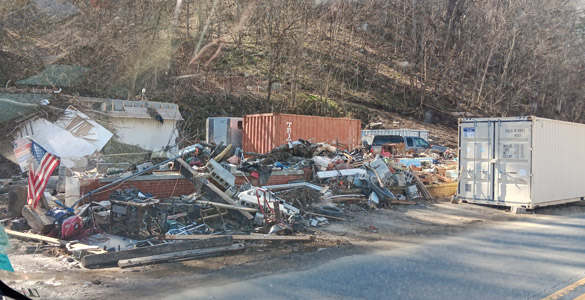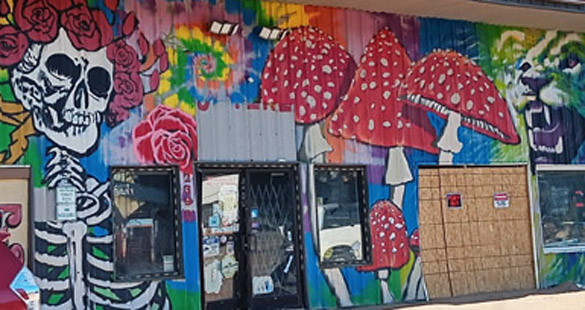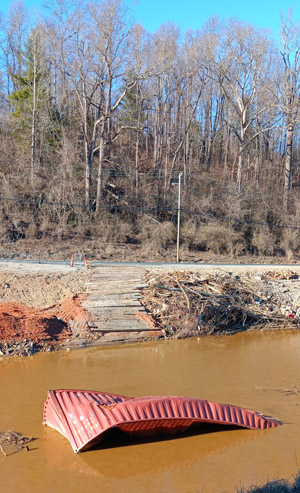Here I am in Asheville, five months after Hurricane Helene ravaged my favorite city, finally getting away for a few days to join the ongoing relief efforts of my friends at Grassroots AID Partnership. Unfortunately, I haven’t missed my chance to help out. But that’s fortunate for me, because it pries me away from my inbox, where email after email reminds me that our nation is facing a far worse disaster than floods and hurricanes: bitter division, rank deception, chaos and corruption . . .

The mountain skyline is as breathtaking as ever, but the devastation is heartbreaking. Riding with my friends Aslan and Tenali to deliver boxes of food to small towns in the mountains, I see piles of debris everywhere along the roads. Fallen trees large and small have been cut up and stacked haphazardly where they fell. Here and there the battered carcass of a car perches where the floodwaters abandoned it. Miles of riverbank are lined with trees that lean precariously out over the water. In many places the rivers have cut new channels through wide expanses of muddy wasteland left behind by the flood.
Aslan tells me that over a thousand bridges were washed away, many of them on private land, the only access to homes separated from the road by a river. We see the wreckage of many houses, some reduced to heaps of rubbish. Landslides and flooding took over 200 lives, not including an unknown number of homeless folks camped on the French Broad River in Asheville. The River Arts District, a community vortex of art studios, galleries, coffeehouses and performance spaces, was completely wiped out.
My friends are running GAP on a shoestring while they await a newly approved grant from the Red Cross, funneling food through their warehouse in Black Mountain. Baseline funding from the Dr. Bronner’s soap company and the Organic Valley farmers’ coop covers fuel for the trucks, light and heat for the warehouse, and a small stipend for the GAP team. Representatives of both companies serve on GAP’s board, and its executive director, a mechanical whiz generally addressed as “Doctor Dave,” also moonlights for Dr. Bronner’s. The food comes from several sources, some of it donated, some purchased wholesale at a nonprofit discount.
Every Sunday the warehouse comes alive with music and voices as volunteers crowd in to form an assembly line, filling boxes with produce and dry goods as they move down a long row of tables. But I’ve arrived on a Tuesday and the cavernous space is quiet. Its concrete floor is a maze of pallets of food and supplies, miscellaneous equipment, broken-down boxes waiting to be recycled, a pickup truck up on jacks. In one corner a box truck stands loaded and ready for a mission to a fresh disaster now unfolding in Kentucky, where icy floods have claimed two dozen lives.

Normal Standards No Longer Apply
Tuesday’s deliveries go to a food hub in a town called Barnardsville. Aslan, Tenali and I load Aslan’s pickup with cube-shaped boxes, each packed with an assortment of veggies and packaged foods – rice, peanut butter, cauliflower, tomatoes, onions, carrots, bell peppers. Just enough room is left for a cooler of frozen pork chops. Until recently GAP has been getting by on empty boxes scrounged from nearby supermarkets, but they have now received a shipment of brand-new boxes printed with their circular logo. Taping boxes together is now part of the Sunday routine.
While we wait for a text from the folks on the receiving end, I pass the time by filling two dozen ziplocs with fragrant scoops of basmati rice, label them with a marker and add them to the stash for Sunday. The protocol for this requires latex gloves, something a recycling purist like me normally disdains – just as the vegetarian in me would normally shun handling pork chops. Not this time. A disaster is a disaster. People have to eat. Normal standards don’t apply.
The folks at the Big Ivy Community Center are happy to see us – mostly. When I ask a young man leaning on a motorcycle how he is, he answers simply, “Alive.” Two young women appear towing four-wheeled carts. Together we stack both carts high with cardboard cubes and empty the truck in two trips. Big Ivy’s large main room is a miniature replica of the GAP warehouse, with various types of food sorted and ready for distribution. Smiling volunteers unload the carts, mostly women, while keeping track of half a dozen rambunctious kids.
Aslan and Tenali have both been working in disaster relief since Hurricane Katrina demolished the Gulf Coast in 2005. A crew of veteran Rainbow gatherers converged in Waveland, Mississippi, and teamed up with a church group from Texas to provide hot meals, medical attention and survival supplies to the hard-hit locals. Afterward the Rainbows formed “American Rainbow Rapid Relief” and took their harrowing but exhilarating experience on the road. GAP is a reincarnation of ARRR, now incorporated as a nonprofit, born of many more years of rescue work in the aftermath of disaster.
On the drive back to the warehouse, Aslan explains that there are three phases to that work. First comes relief, when people who have lost everything need direct assistance. GAP spent the first two months after Helene cooking and serving hot meals, delivering portable showers and porta-potties, and setting up water filtration stations, Rainbow-style. Then comes recovery, the current phase, when people are housed again, at least temporarily, and can cook their own meals if GAP provides the groceries. Finally comes resilience, when the job shifts from bringing in truckloads of food to purchasing it from local farmers. The goal is to boost the local and regional economy while preparing for the future by bolstering the area’s overall self-sufficiency.

“We’re Finally On Our Own” . . . Again
The funds from Red Cross will raise my friends’ minimal stipend to a living wage through the duration of the grant. But their motivation for creating GAP springs from the heart, an instinctive human response of compassion and care for other humans in need. They are joined in the effort by dozens of part-time volunteers, also drawn by the need they see. Aslan and Tenali affectionately describe the crowd that gathers every Sunday to pack boxes: hippies and Green Berets, college students, church groups, veterans, old and young, black, brown and white, talking and laughing, getting to know each other as a natural side effect of showing up to help.
On Wednesday I ride with Tenali on another delivery run, this time to three hubs in Yancey and Mitchell Counties. At each stop we are met by more volunteers, greeting us with smiles, willing hands and heartfelt gratitude, each an enthusiastic node in the network of support for their communities. At a tiny Catholic church, the people we see taking home a box of food are mostly Spanish-speaking. At a converted middle school, a silver-haired volunteer in camo calls his service in the Navy Seals “the best 22 years of my life,” adding that under this administration he would gladly do it again. But no one asks who we voted for, what we think of illegal immigration or trans rights. We are all people, helping people simply because they’re people, whether neighbors or strangers, red or blue, black or white or brown.
I learned long ago that there are few privileges more rewarding than that of service to others. I learned it early in life from my parents, who took their Christian faith not as a license to judge but as an invitation to serve. I call it a privilege because the only reason I am in a position to serve is that this particular hurricane veered toward Asheville instead of toward me. I never felt a need for the trappings of Christianity, but when I discovered the Rainbow Gatherings, my family background merged seamlessly with the Rainbow creed of taking individual responsibility for the needs of the Whole.
Every volunteer in a good cause understands that feeling. We may be motivated by religious faith, ethical principles, or love for humanity, but undeniably it is also personally fulfilling to give, share, help and serve. Psychological research links this to our ancient genetic heritage of tribal community . . . which can also evoke a xenophobic tribalism that splits the world into “us” and “them.” But in a natural disaster scenario, people are people, and tend to see each other that way.
Not all disasters are natural, however. The new administration’s agenda seems either deranged, boneheaded, or intentionally designed to crash both the climate and the economy. Why intentionally? Trump and Musk might be deranged, but they’re not stupid. As Bob Marley once explained, “A hungry mob is an angry mob.” What better excuse to declare martial law and suspend the Constitution than an mob of unemployed liberals and gun-toting conservatives looting a grocery store? Hey, I’m just asking.
Undoubtedly the next four years will cost us many tragic losses. But my experience in Asheville gives me hope that people will meet each inevitable disaster by banding together to form instinctive communities of heroism, compassion, and heart. It may be the only way out of the trap of toxic individualism and ideological extremism that drives the deepening polarization of America. Our answer to the right-wing strategy of “divide and conquer” must be to recognize each other as people at last, and come together in the middle.
As the Grateful Dead once pointed out, “It’s all too clear we’re on our own.”

Note: These are my personal opinions and do not represent any organization I’m involved in. If my words resonate for you, please share widely. You can subscribe (or unsubscribe) at StephenWing.com. Read previous installments of “Wingtips” here.
 Wing’s original
Wing’s original
stickers available at
GaiaLoveGraffiti.














Thank you for the current hands-on report of recovery efforts in Ashville
Thanks you for telling us what the crisis is like there and how many people still need help. Thank you and your friends at GAP for feeding people.